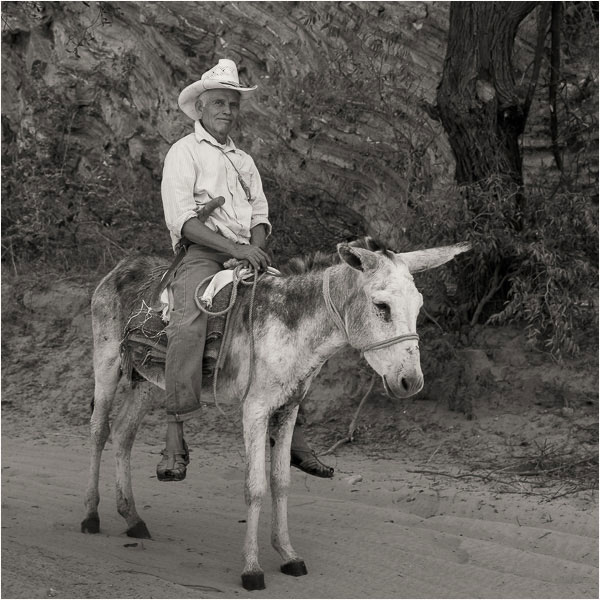
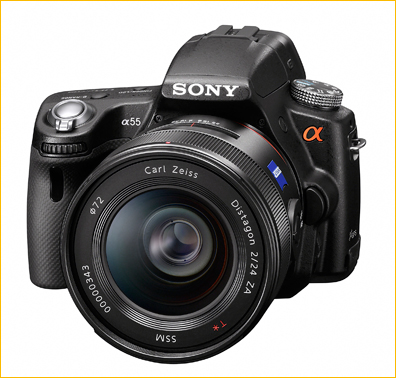
Sony A55 With Zeiss 24mm f/2
It isn’t often that something really fresh comes along in this industry. There are new models every few months, but usually these are simply thesame oldwith a bit of addedchrome.
But Sony, who are really gaining momentum in the still camera industry of late with their NEX series still and video models have just launched two new cameras, the SLT-A55V and A33, which will cause their competitors to have a few sleepless nights, and uncommitted camera buyers to look very carefully at what Sony is offering. Current Sony Alpha owners will, I forecast, buy these two new models in droves. Lets have a look at why.
____________________________________________________________________________________
Disclosure
In mid-August, 2010 along with a small group of web and print journalists I had an opportunity to shoot for several days near Jackson Hole, Wyoming and Yellowstone National Park. This outing was sponsored by Sony so as to allow an opportunity to meet with Sony engineers and marketing folks to ask questions and learn about the A55/A33/A560 and VG10 while working with them. Please read myFull Disclosurestatement for my policy on attending such events.
____________________________________________________________________________________
The Basics
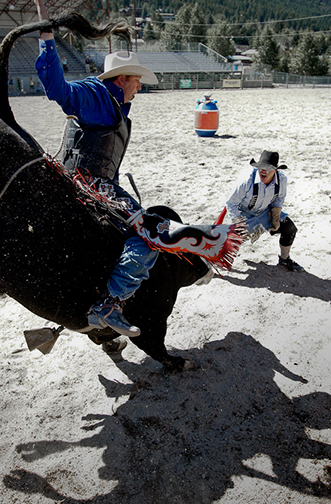
Ride ’em. Jackson Hole, Wyoming. August, 2010
Sony A55 with 16-35mm @ ISO 500
1/1500 sec
Let’s start with a mention that this report (not yet a full review) is primerily about the just announced A55. The A33 is a very similar camera (lower resolution sensor and lower maximum frame rate), and since the A55 is only $100 more than the A33, I expect it to be the more popular model.
So with that out of the way, here are the main bullet points…
– 16.2 Megapixel Exmor APS CMOS (14.2MP for the A33)
The A33’s sensor is the same as in the NEX 5 and VG10 camcorder. The A55’s is similar, but with a higher pixel count.
– 10 frames per second shooting rate (yes, you read that right). The A33just7FPS.
The buffer size is 35 Fine JPGs and 20 raws, or raws + JPG. When full though, it can take a while to clear.
– Smaller size and lower weight than previous Alpha series DSLRs; about 20% smaller and lower
– Use of a pellicle mirror ("Translucent Mirror Technology") instead of a rapid return reflex mirror
– A fully articulated LCD 3-inch 921,600 Xtra Fine LCD with TruBlack™ technology and 100 percent coverage.
– Use of a 1.1 million dot electronic viewfinder (Tru-Finder) with 1.1X magnification and 100% coverage
This EVF is claimed by Sony to have a wider gamut and faster refresh than any used to date
– Continuous live view while shooting stills and video on both the LCD and EVF
– 1080p/30 HD video with continuous high speed autofocus while filming using phase detection
– Built-in GPS for image tagging with location (A55 only)
– Standard SD card capability including both SDHC and SDXC formats (and Sony Memorystick for you Sony diehards)
– Compatible with all Sony Alpha series and legacy Konica/Minolta lenses
– In body stabilization usable with any lens
– The full compliment of current Sony shooting features are included, including Sweep Panorama, Auto HDR which shoots and combines three frames into a single high dynamic range (HDR) photo, multi frame Noise Reduction which combines six separate frames into a single photo, and more additional modes and gizmos that you can shake a stick at.
Oh yes, there’s even what Sony callsAUTO+(Advanced Auto) mode, which will choose any of the above depending on what it thinks best. Just the thing for when you’re too tired to do more than press the shutter release.
– In the U.S. the A55 and A33 cameras will cost about $750 and $650 (respectively) for the body only and about $850 and $750 (respectively) for the body and 18-55mm kit lens. The A33 camera will be available in September, and the A55 will be available in October.
____________________________________________________________________________________
An Overview
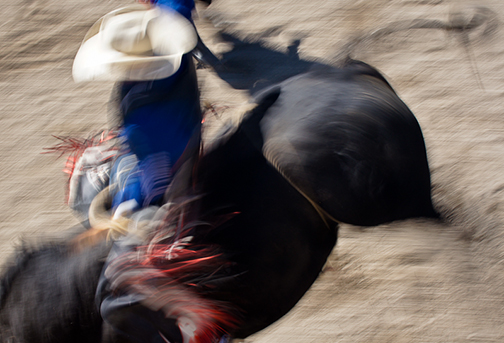
Buck’n. Jackson Hole, Wyoming. August, 2010
Sony A55 with 70-300mm @ ISO 100
1/15 sec
What makes the A55 exciting (and unique in today’s marketplace) is that it uses a pellicle mirror instead of a rapid return mirror. What this means is that the reflex mirror doesn’t move during the moment of exposure. It is stationary, and part of the light is diverted to the metering and AF sensors while the rest pass through to the main sensor. This mirror doesn’t move between frames and a great many benefits arise from this.
Pellicle mirror technology isn’t new. Canon used it first in 1965 in theCanon Pellixand both Canon and Nikon had models with Pellicle mirrors during the 1970s.You can read more about the history here.
Sony calls their pellicle mirror "Translucent Mirror Technology". Its use in the A55 (and A33) allows for some significant capabilities that have never been seen before in either a still photography or a video camera. The most important one is that phase detection autofocus can be used continuously while shooting at up to 10 FPS. DSLRs with moving mirrors can not shoot at this rate (even if they can shoot this quickly) and still offer continuous AF, because there simply isn’t enough time between frames for the AF to do its thing. Instead what is known aspredictive autofocusis used, where the camera attempts to guess where the subject will be in the next frame. This works pretty well most of the time, but only if the subject is moving at a continuous speed and in a constant direction.
But on the A55, because the phase detection AF sensors is able to see the subject continuously while either shooting stills or video, it can track the subject very accurately. According to Sony it can track a moving subject at between 30-40 MPH while shooting 16MP stills at 10 FPS. When shooting 1080P video it can continuously track a moving subject at up to 50 MPH. I’m not usually given to hyperbole in these reviews, but this is a stunning capability, and has to be experienced oneself to be really appreciated the breakthrough that it represents!
I don’t have an image sequence to illustrate this with stills (I will when I can produce a full review, hopefully in a few weeks), but on our Jackson Hole, WY junket I was able to shoot a barrel rider at a rodeo using the A55 while shooting video. The clip below shows this, and while my camera work is a bit jerky (youtry following a rider moving at about 30 MPH on an irregular course, using a long lens), the focus tracking is extremely good, right up until the rider came so close that the lens couldn’t focus any closer. I know of no other video camera that can track AF like this, at any price.
Click on the above image to play a brief video shot with the A55 in a new window.
This file may have to fully download before playing.
A high speed connection is highly recommended.
Shot at 1920X1080 but has been scaled down to 1280X720 for the web.
There are quite a few other tricks up the A55’s sleeve, so let’s have a look at some of them next.
____________________________________________________________________________________
LCD & EVF
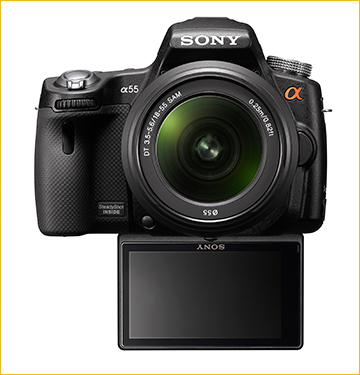
What I expect to be one of the more controversial features of the A55 is its electronic rather than optical viewfinder. After using the similarly endowed Panasonic GH1 with success for the past year or so I have to say that I don’t regard the move away from optical viewfinders as that big a deal anymore. The EVF found in the A55 is in fact preferable to any of the reduced frame optical viewfinders that I’ve used, because of its much larger image, (1.1X) and high eye point. It also offers 100 coverage, which only expensive DSLRs offer on top models. The tunnel view of most consumer reduced frame DSLRs really inhibits viewing, and so in many ways the move to a large EVF is an improvement.
Q:Do you expect to use the translucent mirror technology on a camera with an optical viewfinder?
A:No comment.🙂
Of course having an EVF means being able to shoot with the A55 at eye level for both stills and video, rather than just on the LCD with Live View. This is a big plus, and one of the things that has made the GH1 so popular.
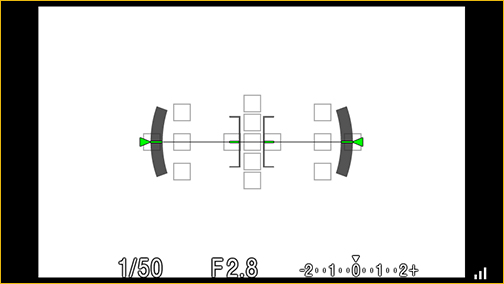
One of the advantages of an EVF over an optical viewfinder is that it can have a variety of overlays. Among others Sony has implemented a horizon bar to show when the camera is level, and it works well.
And finally, there is eye detect, so that viewing switches between the LCD and the EVF automatically as you raise it to eye level.
I did notice that the EVF seemed to have a cyan cast that was not present on the LCD. This was visible on all of the cameras that we had for testing. Since these were preproduction cameras I imagine that this will be corrected before full production begins.
The LCD is the same as used on the NEX5, and it’s high resolution and bright. It’s also fully articulated, a first for Sony on an Alpha camera.
____________________________________________________________________________________
Sensitivity
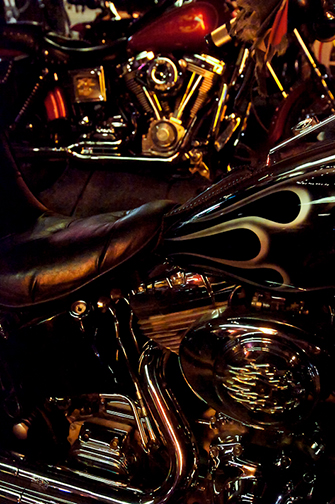
Hog at Midnight. Jackson Hole, Wyoming
Sony A55 with 16-35mm @ ISO 12800
The A55′ sensor is based on the one used in the NEX 5 and VG10, except with a slightly higher pixel count. The A33 uses the same NEX 5 sensor. It has received very favorable comments by reviewers and testers, and my experience with it in this and other cameras is that it is at least as good if not better in many of its characteristics than sensors from other makers.
Since the launch of the Sony Alpha series Sony has not had a particularly sterling reputation when it came to their sensor’s high ISO noise capability. But I have recently been particularly impressed by the combination of high ISO with this sensor when used together with Lightroom 3 or the latest Camera Raw. Shots at ISO 12,800 are usable when this combo is used – even with JPGs.
____________________________________________________________________________________
Autofocus

Shaken But Not Stirred. Jackson Hole, Wyoming
Sony A55 with 70-300mm @ ISO 100
The A55 has a newly developed 15-point AF system with three cross type sensors. This is a nice step up from previous Alpha AF systems but in my brief testing doesn’t appear to be quite up to the continuous phase detection autofocus system discussed elsewhere in this report.
____________________________________________________________________________________
Dust and Light Loss
One of the big questions that potential users will have is with regard to light loss due to the pellicle mirror, and also potential dust and reflection issues.
According to the engineer that designed the translucent mirror system (who was at the Sony meeting which I attended), these were considerable challenges but have been dealt with. No one at Sony would comment officially on the percentage of light loss, but I’d guess it to beabout a third of a stop.
As for dust, reflections and other pitfalls, apparently special coatings have been applied to the mirror which are intended to deal with these. When I have a camera for more extensive testing I’ll report further on this. But, to my knowledge none of the journalists that tested these cameras in rather dry and dusty conditions for three days in Jackson Hole saw any dust problems. I know that I didn’t.
Video

Click on the above image to play a brief video shot with the A55 in a new window.
This file may have to fully download before playing.
A high speed connection is highly recommended.
Shot at 1920X1080 but has been scaled down to 1280X720 for the web.
Sony now has video on all of their new camera models, and implementation is very smooth and quality is high. The A55 shoots full HD 1920X1080 at 30P, wrapped in a 60i envelope. (See myrecent VG10 reviewfor more on this).
As discussed and shown earlier in the review the addition of continuous phase detection autofocus while shooting video is a significant new development which is going to prove appealing to both still photographers and videographers.
There is aAchilles Heelthough, which needs to be understood. PDAF (phase detection autofocus) is done with the lens at its widest aperture. This means that if you want to shoot video with PDAF you lens will always be used at its maximum aperture.
Note that this isn’t a Sony thing. It’s the way PDAF works on all DSLR. We just haven’t been aware of it before because a DSLR views and focuses wide open, and then when the shutter is pressed the lens stops down for a moment to the selected or required shooting aperture. On the A55, because of its pellicle mirror, when shooting video with PDAF the camera needs to similarly have its aperture wide open.
If one wants to shoot video at a smaller aperture this is possible, but AF is disabled. For narrative shooting this is likely not getting to be an issue.
It needs to be said though that this is the A55’s Achilles Heel. As fantastic as phase detection AF when shooting video can be there are times when either shooting wide open or not at all just isn’t satisfactory.
I asked Sony’s engineers whether there might be a way to incorporate contrast detection as well, at the user’s selection, but didn’t get a satisfactory answer. My guess is that this is something that’s possible, but is being reserved for the higher end translucent mirror models that are inevitably coming.
____________________________________________________________________________________
Looking Ahead

The A55, will I believe, be regarded as something of a landmark camera. It offers a significant amount of new technology in a surprisingly inexpensive package. It challenges the big boys, Canon and Nikon, to get off their butts and start offering something new and exciting.
The global recession has caused many companies to pull in their horns and play it safe. Sorry, but though I’m no Harvard MBA, this strikes me as wrong-headed. When times are tough if you want to get noticed and increase market share (or preserve it) you innovate. That’s what Sony appears to be doing this year and I expect that it’s going to pay dividends in increased sales.
The NEX cameras are selling like gangbusters, and Panasonic hasn’t been able make enough G series 4/3 cameras for the past 18 months to keep up with demand. Nikon and Canon? Not an EVIL in sight. Maybe soon.
Though Sony’s reps are silent on the subject, I fully expect them to follow up on the A55 and A33 with additional new models, possibly as soon asPhotokinain late September orPhoto Eastin N. Y. in late October. Expect to see these new sensors and the translucent mirror technology in a succession of new cameras in the days ahead. Exciting times. It looks like Sony is on a roll.
As soon as I can get a production A55 for further use and testing I expect to follow up on this review in greater detail.
____________________________________________________________________________________
Inquiring Minds Want to Know
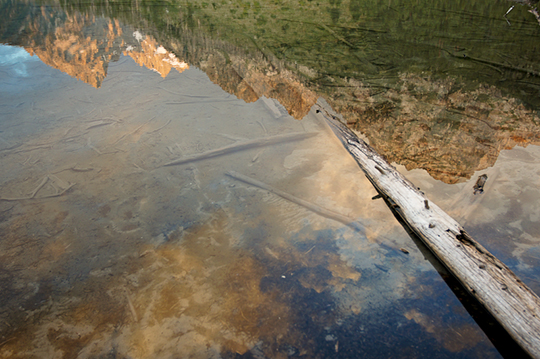
String Lake Dawn. Wyoming. August, 2010
Sony A55 with 16-35mm @ ISO 200
Given my somewhat critical recent reviews of theSony NEX5andVG10, why does it appear in the above that I’m giving Sony a pass on the A55?
Actually, I’m not. If there was something obvious (besides small aperture video with AF) to be critical of –trust me– I’d be the first to point it out. But in the three days that I had to work with the A55 (and the VG10 and the A560– a very full plate) I didn’t find much to be critical of. It seems to be a very well sorted new camera, with a lot to like and not much to be critical of, especially at its price point.
Of course once I get my hands on one for a few weeks of more intensive use I’m sure I’ll find something to diss, but for the moment all I can say is that the A55 looks to be a winner. I wouldn’t even be surprised if I end up buying one myself.

August, 2010
You May Also Enjoy...
SK-Sedona-Workshop
Steve Kossack is an experienced photographic guide to the American Southwest. His tours and workshops, operated under the nameF-8 And Be There, allow visitors to
Michael Reichmann – Reflections
Like other visual artists let's have the courage to create images that express how we imagine a scene was, rather than just what the camera
